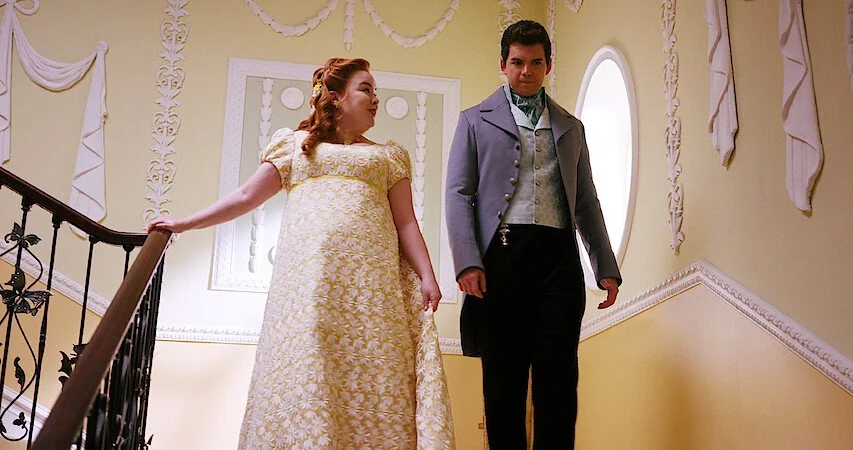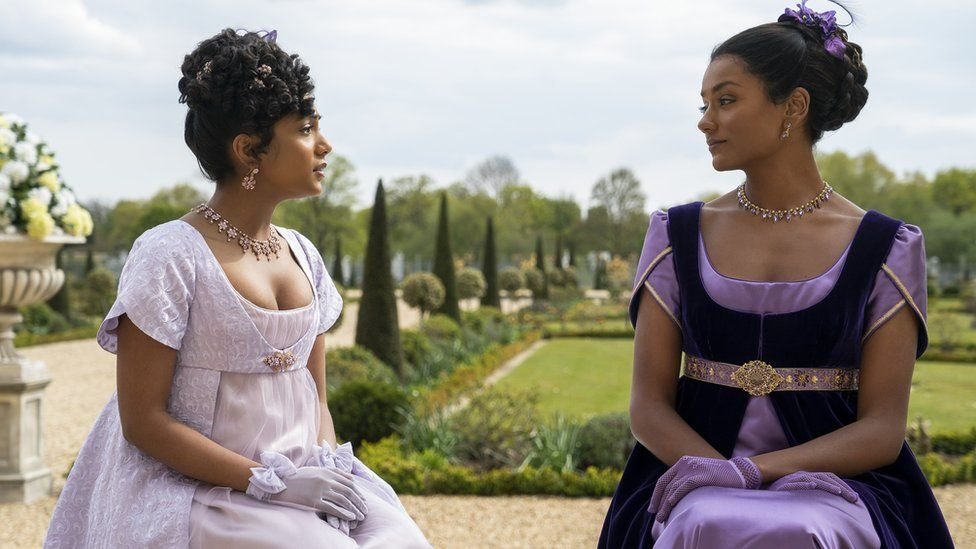By Tatiana Parkhomova (she/her)
Content warning: mentions of fatphobia, homophobia, bias against sex-workers
After the release of the third season of Netflix’s top-rated series Bridgerton, discussions around the show have not ceased. Media articles report on the show's raw portrayal of ‘mixed-weight’ romance as well as the negative reactions to the insertion of queer characters not featured in the books. For weeks, Reddit users have been debating whether the latest season meets their expectations, with heated arguments about accuracy of adaptation and character portrayal.
What do all of these discussions have in common? Most discourse stems from how diversity is portrayed in the show. Unlike the book series, the show prides itself in implementing diversity while telling a fictitious story set in Regency-era London.
In the show, people of colour (POC) have equal standing in England’s high society, while plus-sized and neurodivergent people are represented as key characters who influence the plot. Bridgerton has embraced themes of gender equality as well as disability and LGBTQIA+ representation. Controversy sparks from the pitfalls in such representation, and showrunners have been accused of implementing Netflix’s superficial ‘ticking-the-box’ diversity. In contrast, some fans believe the show has become ‘too woke’ and no longer stays true to the books.
This poses a question: Is the show’s diversity and inclusion representation fair and sufficient, or does it need significant improvement?
Positive aspects of representation
First, it is important to note what aspects of the show’s diversity are successful. Perhaps the most noticeable way of implementing inclusion has been a racially and ethnically diverse cast. POC characters can be seen in all roles: from lords to servants. Many important and recurring characters are also played by POC actors, such as Queen Charlotte, Kate Sharma (the new Lady Bridgerton), and Lady Danbury. POC characters are also seen in mixed-race marriages.
With the new season, there has been more neurodivergent and disability representation. A Deaf character using British Sign Language was spotted multiple times throughout season three, and despite her not having a pivotal role in the show, representation was still noted. Moreover, fans suspected that Francesca Bridgerton is neurodivergent, and showrunners have confirmed it. She is more introverted and introspective than her siblings, and she does not enjoy social interactions, instead dedicating most of her time to playing the piano. Online communities have expressed the importance autistic and neurodivergent representation and praised the writers in this regard.
Nicola Coughlan and Luke Paul Anthony Newton as Penelope Featherington and Colin Bridgerton. Credit: Liam Daniel/Netflix
This season, viewers also saw more focus on body type diversity and conversations around women's empowerment. The steamy ‘mixed-weight’ relationship between straight-sized Colin Bridgerton and mid-sized Penelope Featherington has captivated the audience and sparked important conversations about on-screen body type representation. Penelope’s love story does not focus on her weight, but more on her personal development and building confidence, leading to marriage with her childhood friend. This storyline has received conflicting reactions, with some being blatantly fatphobic, as viewers revealed how uncomfortable they are with seeing a ‘mixed-weight’ relationship. Despite this, others have expressed how such representation is important, as it shows that mid/plus-size people can be desirable, confident, and worthy of love.
Lastly, LGBTQIA+ representation has so far been scarce in Bridgerton, with showrunners confirming more queer relationships will be featured in upcoming seasons. Benedict Bridgerton is hinted to be bisexual, as he explores relationships with both men and women, seemingly still learning about his sexuality.
Room for improvement
Despite the positive aspects of diversity in the show, there is still room for growth. Showrunners have been accused of implementing surface-level diversity instead of exploring it in depth. For instance, neurodivergence depiction in Francesca was limited to a few qualities and lacked explanation. It was noted that the latest season did not have any childhood flashbacks like the previous ones, from which the viewer could learn more about the main characters. This is a missed opportunity to explore Francesca’s past as a neurodivergent child. It was also noted that disability is not specifically explored, and characters with disabilities have such a limited appearance that it can almost go unnoticed. The viewer does not learn much about these characters, and their purpose is sometimes limited to visual representation.
It is also important to discuss the intersection of LGBTQIA+ romance and sex work on the screen. Bridgerton received criticism for portrayal of nameless female sex workers, who engage in threesomes with aristocratic men and lesbian sex for display. Nude women are used for contrast, as the male lead inevitably marries a young chaste lady of the Ton, while sex workers aid the men in ‘maturing’. Such sex scenes can be seen as unnecessary and misogynistic, as sex workers are used as a tool to enhance romantic relationships and male-lead character development. When these women are no longer needed, they are eliminated from the show. For instance, this happened to Siena, Viscount Bridgerton’s ex-mistress whose story ended after he decided to get married.
Sisters Kate and Edwina Sharma. Credit: Liam Daniels/Netflix
Moreover, some critics have debated that POC characters are there to further the narrative of white characters, or simply to fill the background roles of London aristocrats. An example of this is Kate Sharma and her sister, Edwina Sharma. Kate Sharma, a character of Indian descent, has married Viscount Bridgerton, and the third season sees her in the role of a Viscountess. Her sister Edwina was eliminated from the show after serving her role of advancing her sister’s relationship. The show chose not to explore the sisters’ culture beyond a few brief elements. In this instance, the show could have benefited from continuing to explore interesting POC characters like the Sharma sisters, instead of eliminating them or giving them limited screen time and development in newer seasons.
Recommendations
Showrunners could implement a more explorative approach to race and social class, which could advance stories of POC characters. As much as visual representation is important, it would be interesting to see how culture and traditions intersect in mixed-race marriages, or the backstories of POC characters who have encountered discrimination before all races were made equal in the Bridgerton story world. POC characters could also receive more distinct roles in society and the plot, with unique storylines that do not revolve around white characters.
As for other types of diversity, it is important to remember that quality over quantity often leads to better results. Instead of ‘ticking the box’ and adding as many characters for inclusion as possible, the show could explore the identities of existing characters in a more detailed and meaningful way. For example, the exploration of queer identity through a romantic storyline rather than explicit sex scenes. The same approach can be applied to disability, by engaging with the character’s identity in a nuanced and purposeful way.
When Netflix shows like Bridgerton seek to please and attract viewers through diversity, it is important not to take a tokenistic approach. The show is certainly unique in its genre and has already done great work in representing diverse characters, but there is always a little more to strive for. Let us hope that future seasons will show us enhanced diversity that meaningfully engages with identity.
Got a feminist opinion you want to share? We want to publish your work! Anyone can contribute to the OWP blog, no experience necessary! Find out more about being featured on our blog.
Sources:
https://www.vox.com/culture/24161106/bridgerton-race-queen-charlotte-will-mondrich-john-stirling
https://www.thegazelle.org/issue/197/bridgerton-hollow-diversity-race
https://historyatnorthampton.com/2022/04/21/bridgerton-race-and-history/
https://www.vox.com/22215076/bridgerton-race-racism-historical-accuracy-alternate-history
Header image credit: Liam Daniels/Netflix



